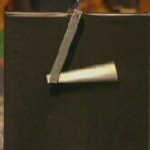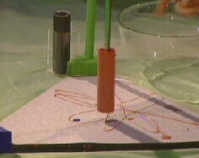Royal Institute Christmas Lectures 2006
The Quest to Predict the Future
Predictions
The Balls Experiment
How can mathematics help to predict future events? Professor du Sautoy begins by considering a football! The whole story of how we can predict the future actually starts with trying to understand simple objects like a football. Starting at the beginning we are told that Aristotle believed that the heavier an item the faster it would fall to earth. It wasn't until the 1600s that Galileo proved that this was not the case.
Leaning Tower of Pisa
Professor Marcus du Sautoy recreated Galileo's experiments using a model of the leaning tower of Pisa, where Galileo had used the original, in a very simple experiment to demonstrate that two dissimilar object would fall at the same rate. We are told that although a feather will fall slowly this has nothing to do with it's weight but has to do with air resistance. If a feather and a football were both dropped in a vacuum they would fall at the same rate.

Trajectory Formula
Trajectory
It is a relatively simple formula to determine the rate at which a ball descends in a straight line, but now we wish to predict where a ball will land after it has been kicked. The trajectory of the ball is determined by such factors as the initial velocity (the kick) the starting angle and gravity. This is still fairly simple as there are few variables.

Double-Pendulum
Double-Pendulum
A simple pendulum is very predictable and is used to measure time. A double-pendulum however, is a very different matter. As the upper part of the pendulum swing the lower part swings freely and can rotate either clockwise or anticlockwise. The behaviour of a double-pendulum is so erratic that it is termed chaotic. The Chaos Theory was discovered, over a hundred years ago, by a Frenchman named Henri (Henry) Poincare, he was interested in trying to establish if the Solar System was stable. In a further experiment we look at the predictability of planetary trajectories with a simple model using a free-hanging pendulum and three magnets to simulate the gravitational effect.

Trajectory Formula
Planetary Trajectories
In this experiment the pendulum is attracted to the magnets so, as it swings and passes close to one of the magnets it's path is altered. This change may take it towards or away from another magnet before momentum brings it back on the return swing. The pendulum trickles paint as it swang to record the pendulum movements. Eventually the pendulum settles over one magnet. Repeating the experiment showed it to take a very different course coming to rest over a different magnet. This apparently proved Poincare's theory that, in something as large as the Solar System, even a small change can have huge consequences. Scientists in Oxford have run simulations on supercomputers which have proved that, for at least the next few billion years, the Solar System is stable.
Lemmings
It is a well-known fact that Lemmings will, periodically, commit mass-suicide by throwing themselves from cliffs. Well, like so many things this is a myth. The real reason for sudden Lemming population drops can be shown mathematically with population models. At times an apparently steady and predictable population will become chaotic with large rises and sudden drops and is probably accentuated by the Lemmings short reproductive cycle.
